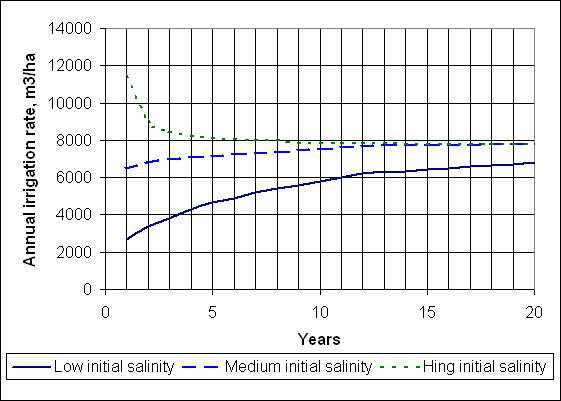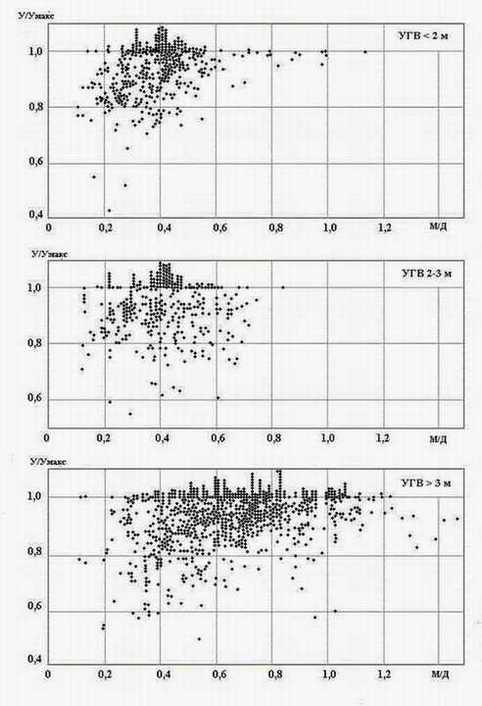Preliminaries
Here, we are going to touch closely on two questions, which so far
are not considered when rationing water consumption and developing
crop irrigation regimes:
- taking into account moisture-salt transferring in soils;
- taking into account features and consequences of application one
or another irrigation technique.
We think until these problems are not considered somehow when making
designs, schemes, feasibility studies, it is incorrect to talk about
ways of solution of the Aral region problem, at least for Uzbekistan,
Kazakhstan and Turkmenistan. So, let us consider:
1.
Role of taking into consideration moisture-salt transferring in soils
when designing crop irrigation regimes and making interpretation of
field tests' results.
Taking for a basis of argumentation fundamental laws, determined by
great M.V.Lomonosov as early as in the beginning of XVIII century,
we will try to examine salt balance in soil if there is no salt withdrawal
through drainage or to sub-horizons under following typical ideal
conditions reflected in table 1.
Table
1
| Indices |
Units |
Values
|
Deficiency
of air moisture for a period of IV-IX months
|
m3/ha
|
10000 |
Evaporation-transpiration
(cotton in the zone C-1-A)
|
m3/ha |
6500 |
Including
at the expense of irrigation water
|
m3/ha |
4500 |
Mineralization
of irrigation water
|
g/l |
1,0 |
Salt arrival
along with irrigation water for vegetation
|
t/ha |
4,5 |
This
(the last item of the table) amounts to approximately 0.3 % a year
of soil meter layer's mass, out them around 1/3 part, or totally 0.1
% a year are toxic salts. That is, it is obvious, without salt withdrawal
out of soil's root-inhabited layer it is impossible keeping long irrigated
agriculture, since for several years the soil will become alkaline
soil just because of salt arrival along with the irrigation water.
Passing "boring" story about how scientists came to the
idea of leaching irrigation regime, we'll attempt to illustrate a
concrete forecast (applying moisture-salt transferring models available)
on how the requirement for irrigation water will change if to set
the following terms and limits, shown in the table 2, and what formed
regimes will be for many years.
Table
2
Terms and limits while modeling
| Parameter's
name |
Unit |
Value
|
Degree of drainage
of the field
|
1/m |
0,0010
|
Irrigation water
mineralization
|
g/l |
1,0 |
Total pressure
(full potential) of soil moisture in the root-inhabited layer
for normal plant growth, not more than:
|
atm |
4, 0 |
Design layer
of soil within the range of
|
cm |
5-120 |
Initial extent
of salinity - not salted
|
t/ha |
0,00 |

Fig.
1.
Let
us try to comment the figure:
a)
Irrigation regime changes with time, approaching asymptotically
to the steady one (characteristic of given terms).
b) Change of irrigation regime takes place as soil water-salt
regime (SWSR) forms under given natural and technical conditions
(in this example - towards increase of water use to keep stable
SWSR; but, if to begin an experiment when the soil is too salted,
the process will go to inverse direction, but, anyway, it will
come to the steady regime).
Of course, these are forecasts on imitation models and no more,
but, if anybody knows of conducting such experiments in field
conditions, we could discuss their results. Our data can be considered
as means of experiment planning.
c) If a test on determination of plant's requirement for water
to be began on lands desalinized not enough, and conduct it for
not longer than three years (common duration of tests, most likely,
connected with the term of the executors' post-graduate course),
so, obviously lowered values (compared to those, which will be
required for further) of irrigation rates will be received. And
if, herewith, to make an allowance for that generally post-graduate
students leave for the field only during vegetation period, and
by no way they can account when and how much water was be delivered
in non-vegetation period, it becomes obvious why test data on
relationship between crop capacity and water spending, collected
by us from almost 300 publication works, are so ambiguous, that
the dots on the relationship's schedule look like a "cloud".

Fig.2 Dependency of
relative cotton crop (C/Cmax.exp.) to relative irrigation rate (M/D)
according to test stations' data of former the Union's Research
Institute of Cotton, Kara-Kalpak institute of agriculture and Tashkent
Agricultural Institute.
And,
when graphing it relative values of the crop (Crel = C/Cmax) and relative
water expenses (M/D = Mac. /D) were used.
Here: moisture deficit (D = E0 - P) during a vegetation period in
the year of conducting the experiment;
E0 -evaporability from water surface;
P - precipitation.
The indices marked by mean:
- rel. - relative value;
- ac. - actual value in the experience's variant;
- max. - maximum value in experience.
For
the analysis only such experiences were selected, in which all other
conditions became unchangeable, i.e. on an unchangeable "background"
of fertilizers, agrotechnics, growth and etc., while the water factor
only changes.
Depending on irrigation water mineralization, this process' dynamics
can greatly change. But, if to compare steady irrigation rates, required
maintaining adequate conditions for plant growing under various irrigation
water mineralization (regardless of coming steady regime time), so,
it is obvious, as irrigation water mineralization increases, under
other equal conditions, requirement for irrigation water will grow.
When
at the middle and down stream of the Amudarya and Syrdarya rivers
mineralization reaches 1,5 g/l (that is 4-5 times higher than the
fixed one on rivers' runout from mountains), it is time to take into
account of this factor.
2.
Influence nature of various kinds of losses upon soil water-salt regime
and upon hydro-reclamation systems' infrastructure.
Irrigation water use efficiency in an arid zone, where more than 50
% of lands are subjected to salinization, is influenced too much by
irrigation timeliness, even water distribution over the field area,
as well as by way of its delivery. Nature of this phenomenon is discussed
in the "Irrigation technique is a key to reclamation of salted
lands" section, prepared by the site's author. Besides, this
problem is discussed in detail from point of view of irrigation water
use efficiency and concrete technological water spare size on the
page prepared by a Doctor of Technical Science, Vitaliy Konstantinovich
Sevryughin, in the "Irrigation technique and technology. New
ideas and constructive decision" section, prepared by the site's
author. It is in the second part related to forced extra draining
capacities. As regards to influences of that inefficient expenses
to reclamation state of irrigated lands, they are obvious enough and
described in the literature. But, nevertheless, we shall dwell briefly
on nature of that effect.
Regional and local groundwater pressures generally complement one
another, and their nature on irrigated lands is ridden by inflow availability
from outside, losses from the canals to filtration, laid on the commanding
marks, as well as concentrated losses to deep filtration (Kostyakov
A.N., Fjodorov B.V., Mikhelson B.N., Averyanov S.F. and others). This
natural or arisen due to irrational system's construction pressure
prevents seriously to forming normal water-salt regime.
In the "Influence of irrigation technique on reclamation state
of lands" section an aspect related to inefficient water expenses
during various irrigation methods on a field is considered.
After discussing preliminary observations we will proceed to searching
water consumption normalizing ways and calculations of crop irrigation
regimes, applying "instruments" available - the facts, imitation
models of moisture-salt transferring, technical characteristics of
various irrigation methods, and good sense as well.
In future, if this will interest anyone, we intend adding pages as
follows:
- "The problem's background",
- "Adjusted standards",
- "Strategies being proposed",
- "New standards".
How
to get in touch with us?
Return
to the main pag
|

